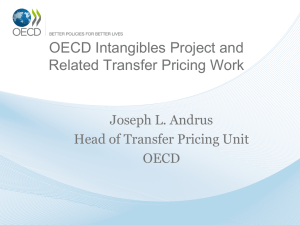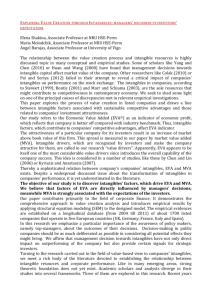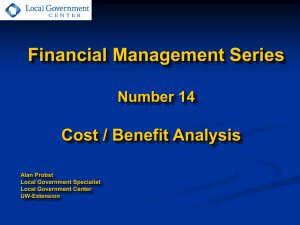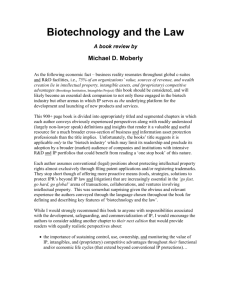Exploring Value Creation through Intangibles: managers' decisions
advertisement
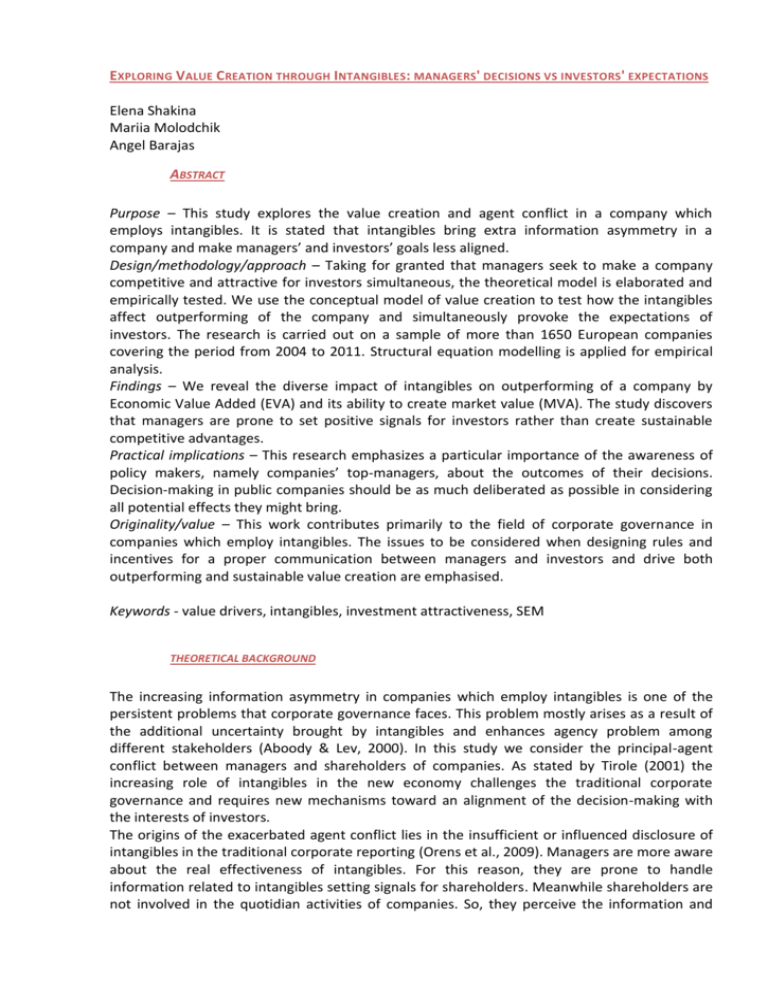
EXPLORING VALUE C REATION THROUGH INTANGIBLES: MANAGERS' DECISIONS VS INVESTORS' EXPECTATIONS
Elena Shakina
Mariia Molodchik
Angel Barajas
ABSTRACT
Purpose – This study explores the value creation and agent conflict in a company which
employs intangibles. It is stated that intangibles bring extra information asymmetry in a
company and make managers’ and investors’ goals less aligned.
Design/methodology/approach – Taking for granted that managers seek to make a company
competitive and attractive for investors simultaneous, the theoretical model is elaborated and
empirically tested. We use the conceptual model of value creation to test how the intangibles
affect outperforming of the company and simultaneously provoke the expectations of
investors. The research is carried out on a sample of more than 1650 European companies
covering the period from 2004 to 2011. Structural equation modelling is applied for empirical
analysis.
Findings – We reveal the diverse impact of intangibles on outperforming of a company by
Economic Value Added (EVA) and its ability to create market value (MVA). The study discovers
that managers are prone to set positive signals for investors rather than create sustainable
competitive advantages.
Practical implications – This research emphasizes a particular importance of the awareness of
policy makers, namely companies’ top-managers, about the outcomes of their decisions.
Decision-making in public companies should be as much deliberated as possible in considering
all potential effects they might bring.
Originality/value – This work contributes primarily to the field of corporate governance in
companies which employ intangibles. The issues to be considered when designing rules and
incentives for a proper communication between managers and investors and drive both
outperforming and sustainable value creation are emphasised.
Keywords - value drivers, intangibles, investment attractiveness, SEM
THEORETICAL BACKGROUND
The increasing information asymmetry in companies which employ intangibles is one of the
persistent problems that corporate governance faces. This problem mostly arises as a result of
the additional uncertainty brought by intangibles and enhances agency problem among
different stakeholders (Aboody & Lev, 2000). In this study we consider the principal-agent
conflict between managers and shareholders of companies. As stated by Tirole (2001) the
increasing role of intangibles in the new economy challenges the traditional corporate
governance and requires new mechanisms toward an alignment of the decision-making with
the interests of investors.
The origins of the exacerbated agent conflict lies in the insufficient or influenced disclosure of
intangibles in the traditional corporate reporting (Orens et al., 2009). Managers are more aware
about the real effectiveness of intangibles. For this reason, they are prone to handle
information related to intangibles setting signals for shareholders. Meanwhile shareholders are
not involved in the quotidian activities of companies. So, they perceive the information and
create their expectation towards the future of companies. The expectations of shareholders
generate the market value of companies.
An information asymmetry puts the CEOs of companies before the following problem: how to
manage resources, which they find reasonable to invest in, following shareholders preferences
(Holmstrom & Milgrom, 1991; Tirole, 2001). Basically, both goals are equally important for
managers that are making investment decisions. If these goals are not aligned, managers have
to accept challenges of principal-agent conflict. In case of controversial goals managers either
should not invest in potentially profitable intangibles or ignore the expectations investors. The
first decision would deprive a company of the outperforming and the second decision leads to
destroy market value and influences on the availability of the capital. This conflict is even more
aggravated by an inadequate motivation system, including compensations for managers and
shortening the cycle of their employment (Bebchuk & Fried, 2003; Edmans et al, 2012). All that
requires an in-depth study for understanding how the agency problem is actualized in
conditions of new economy.
The present study is founded on the value-based concept, introduced in studies of O’Byrne
(1997), Stewart (1991) and Copeland et al (2000). This paper considers Economic Value Added
(EVA©) as an indicator of outperforming which reflects that a particular company is better off
compared with the industry benchmark. The attractiveness of a specific company for its
investors results in an increase of the market value of this firm above its book value. This
spread is measured here by the market value added (MVA).
Intangibles are positively recognized by investors and make the company attractive for them.
They are considered in this research as “value drivers”. Apparently, EVA is one of the main
indicators of the performance of companies for investors since it reflects the overall capability
of a company to succeed. That is reason for considering EVA as one of the key value drivers of
MVA. This idea is introduced in a number of studies, like those by Chen and Lin (2006) or
Kyriazis and Anastassis (2007). Thereby a sophisticated relation between the intangibles of a
company, EVA and MVA exists. Despite the transformation of intangibles in outperforming and
value creation is a widely discussed issue, there is a gap in the literature regarding the topic
presented here. This article emphasises that managers contribute simultaneously to EVA and
MVA making decisions on intangibles. Meanwhile EVA gears intangibles into MVA.
The objective of this paper is to explore the process of value creation through intangibles in
order to shed some light on the agency problem in a company which employs intangibles. On
this framework a theoretical model is elaborated. This model will explain the interrelations
between the decisions of managers on intangibles, outperforming and investment
attractiveness. It proposes a comprehensive approach to value creation analysis. The
theoretical model will be tested on a wide database of listed European companies employing
structural equation modeling. Moreover according to the supposition put forward in this study,
it is expected to reveal the markers of agency problem drawing a line between the decisions of
managers on intangibles addressed to outperforming and those to meet the expectations of
investors.
THE TRIANGLE MODEL OF VALUE CREATION
The research framework of this study addresses to the outcomes of managers’ decisions in
public companies. Two outcomes are suggested here to consider:
The contribution to the creation of competitive advantages, which lead to the
outperforming; and
The contribution to the investment attractiveness, which enables value creation.
Corporate value is the key benefit that attracts strategic investors to companies. Top-managers
of companies meanwhile have to meet investor requirements and anticipate their expectations
in order to bring the capital into firms. They simultaneously have to create competitive
advantages and assuring shareholders and potential investors that the company is likely to
succeed. In terms of the framework of this research, managers should provide both EVA and
MVA growth. However as stated in some empirical studies like those by Biddle et al. (1999) and
Fernandez (2002) and could be theoretically explained, a simultaneous increase in EVA and
MVA is not always possible. According to the reasons explained earlier, this problem is
particularly relevant in companies with a higher level of information asymmetry related to
intangibles.
One principal advantage of the framework of this study is related to the self-sufficiency and
consistency of EVA model for the research purpose here. EVA indicates the outperforming of a
company and at the same time drives value creation (MVA). EVA is moreover an indicator,
which is very closely associated with the intangibles of companies.
Shareholders consider all available information when they have to decide about their capital
allocation. EVA as an indicator of the outperforming is one of the most important factor for the
decisions on investment. At the same time EVA mainly reflects a historical trend of a company.
This information is not always sufficient. Investors take into account those drivers that can
potentially provide a company with competitive advantages. Intangibles are regarded by
investors as key drivers of the future success (Yang and Chen, 2010; Colak, 2010; Huang and
Wang, 2008).
The above-described framework is represented by the triangle model of value creation. This is
the model suggested in this research (figure 1).
External
factors
EVA
MVA
Intangibles
Managers' decisions
direct impact
consideration
Figure 1. The triangle model of value creation
Investors’
expectations
As stated on the figure 1, managers consider goals of outperforming and attractiveness for
investors making decisions towards intangibles. These decisions have influence on EVA. It is also
important that investors analyse EVA and decisions about intangibles. Considering the
information that they extract from both elements, they will have direct influence on MVA.
Moreover there are several external factors that have an impact on EVA and MVA. This model,
which arises from the theoretical reasoning, is tested in the present research.
It should be noted that in this study explores only those relationships that are observed (solid
arrows). Dashed lines are unobservable but influence the relationships, which are examined in
our study.
One of most arguable issues, which have to be challenged in this research, is the identification
and measurement of the intangibles resources. This study applies a slightly modified typology
elaborated and introduced in previous studies. Molodchik et al (2014) introduce six elements of
intangibles. It is established there that intangibles due to their sophisticated nature are hardly
to be expressed in one indicator. A multiple-factor measurement model was applied to
establish relations between elements within each of the components of intangibles. As stated
in the quoted paper each construct of intangible resources of companies is described by a
number of variables, which separately reflect different features of companies’ intangibles. This
approach takes as an advantage the use of data generally available in the annual reports of
companies, their web sites, information bureaus, rating agencies.
The triangle model suggested requires the estimation of the following simultaneous equation
system:
𝐸𝑉𝐴 = 𝑓(𝐻𝐶, 𝐶𝐿, 𝑁𝐶, 𝐼𝑛𝐶, 𝐵𝑃𝐶, 𝑂𝑝𝑝, 𝑦𝑒𝑎𝑟2008 , 𝑦𝑒𝑎𝑟2009 )
𝑀𝑉𝐴 = 𝑓(𝐸𝑉𝐴, 𝐻𝐶, 𝐶𝐿, 𝑁𝐶, 𝐵𝑃𝐶, 𝐼𝑛𝐶, 𝑦𝑒𝑎𝑟2008 , 𝑦𝑒𝑎𝑟2009 )
𝐻𝐶
𝐶𝐿
𝑁𝐶 = 𝑓(𝐼𝑛𝑑, 𝑎𝑔𝑒)
𝐼𝑛𝐶
{
(𝐵𝑃𝐶 )
EVA – economic value added;
MVA – market value added;
HC – human resources capability (cost of employees, productivity, qualification of board of
directors, human brand);
CL – clients’ loyalty and reputation (brand, citation in search engines, advertising expenditures);
NC – networking capability (associations, foreign capital employment, subsidiaries);
InC- innovation capability (R&D expenditures, patents, awards for innovation, intangible assets);
BPC- business processes capability (strategy implementation, ERP system, knowledge
management);
Opp –spatial opportunities (location in capital, proximity of universities, labour market
development according to Global Competitiveness Index)
Ind – industry
METHODOLOGY AND DATA ANALYSIS
The triangle value creation model requires the estimation of a number of latent constructs and
their relationships with endogenous observed variables as can be seen looking at the
introduced system of equations. For that purpose, the study applies a structural equation
modelling (SEM). This methodology enables simultaneous estimation of the relationship
between MVA, EVA and the intangibles of companies. STATA 12 is used to calculate both
formative and reflective constructs of the latent constructs and structural relationships.
The analysis has been conducted using the data of more than 1650 European public companies
during the 8-year period from 2004 to 2011. The empirical part of this research aims to test the
theoretical model presented in the previous section (figure 1).
The information has been collected from companies located in five European countries: United
Kingdom (44%), Germany (24%), France (25%), Spain (5%) and Italy (2%). The entire GDP of
these countries covers more than 70% of the European GDP. The composition of this database
represents the European market according to a country criterion. It also accurately represents
these countries in relation with the industry structure of the European economy. The Statistical
Classification of Economic Activities in European Community (NACE) has been applied and the
following sectors are included in the database: “Management of Companies and Enterprises”
(25%), “Manufacturing” (20%), “Professional, Scientific and Technical Services” (12%), “Finance
and Insurance” (10%) and “other industries” (33%). The representative rate of SME and large
enterprises in the database is 36% and 64% respectively.
The dataset for this study has been collected from a combination of detailed longitudinal
databases, namely Bureau Van Dijk (Amadeus) and Bloomberg. The database consists of
financial and non-financial indicators underlying the variables which reflect several quantitative
and qualitative characteristics of IC. The database includes figures from annual statistics and
financial reports. Other information has been collected from publicly available sources like
company websites, patent and information bureaus, and rating agencies.
RESULTS AND CONCLUSIONS
SEM estimates the system of simultaneous equations introduced in the previous section. The
SEM employs covariation analysis applying maximum likelihood technique. The level of root
mean square error of approximation (RMSEA) of the estimated model in this study is equal
0.087 and reflects reasonably good fit between the sample and the theoretical model,
accounting for degrees of freedom (Browne & Cudeck, 1993).
Table 2 and figure 2 present the results of modelling the simultaneous economic and market
value creation process driven by intangibles.
Table 2. Results of SEM.
Observed endogenous variables:
External
factors
Economic Value Added
Spatial
Opportunit
ies
2009
Latent variables:
Human Resources Capabilities
2008
Innovation Capabilities
Business Process Capabilities
EVA
MVA
Customer Loyalty
Networking Capabilities
Opportunities
Human
Capital
Innovation
Capabilities
Control (time-effect) variables:
2008 year
2009 year
Constant
Customer
Loyalty
Business
Process
Capabilities
MVA
EVA
0.172***
(0.012)
0.137***
(0.028)
0.035**
(0.018)
0.088***
(0.011)
0.539***
(0.018)
0.488***
(0.023)
-
0.097***
(0.029)
-0.080***
(0.020)
0.025**
(0.015)
0.011
(0.020)
-0.120***
(0.028)
0.018
(0.015)
-0.405***
(0.010)
-0.007
(0.010)
1.290
(0.060)
0.005
(0.012)
-0.059***
(0.012)
0.924
(0.026)
*** significance level < 0.01
** significance level < 0.05
Sig. positive
Sig. negative
Networking
Capabilities
Not sig
Figure 2. Results of SEM.
First of all, the study reveals the empirical evidence of the triangle model of value creation. The
significant links between intangibles, EVA and MVA presented in the system of equations have
been proved.
Secondly, as seen in the table 2, there are differences in the influence of intangibles on EVA and
MVA. Human resource capabilities and Business process capabilities introduce positive
significant impact both on EVA and MVA. At the same time, Innovation and Networking
Capabilities have significant but opposite effect on outperforming and value creation. These
intangibles are positive signals for shareholders while decreasing company’s competitiveness.
Customer Loyalty increases the investment attractiveness and has no significance for
outperforming. The apparent discrepancy established in this research is that managers tend to
accumulate intangible resources that are positively recognized by investors. These empirical
results justify the presence of the agency problem the value creation process driven by
intangibles.
Thirdly, the external factors were taken into account by modelling the value creation. The
factors associated with the spatial opportunities did not show significant impact on the
activities of companies. It also should be noted that markets reacted very quickly on the
financial crisis. This is reflected in the significant negative influence of year 2008 on companies’
attractiveness for investors. However these corporations eventually did not go down until 2009.
Only in 2009 the impact of the crisis was palpable.
This study aimed to explore the process of value creation driven by intangibles taking into
account the agency problem. It provided an empirical research that contributes primarily to the
field of corporate governance; and supports the proposed idea that management decisions
towards intangibles have not only direct impact on outperforming of companies and also
generate certain signals for strategic investors. This paper doesn’t imply any particular
mechanisms for the improvement of corporate governance. However the aspects to be
considered when designing rules and incentives allowing a proper communication between
managers and investors and drive both outperforming and sustainable value creation are
emphasized.
This research emphasizes the particular importance of the awareness of policy makers, namely
the top-managers of companies, about the outcomes of their decisions. The decision-making
process in public companies should be as much deliberated as possible considering all the
potential effects that they might bring.
REFERENCES
Aboody, D. and Lev, B. (2000), Information Asymmetry, R&D, and Insider Gains. The Journal of Finance, 55: 2747–
2766.
Bebchuk, Lucian Arye and Jesse M. Fried. "Executive Compensation As An Agency Problem," Journal of Economic
Perspectives, 2003, v17 (3,Summer), 71-92.
Biddle, Gary C., Bowen, Robert M. and Wallace, James S., Evidence on EVA. Journal of Applied Corporate Finance,
Vol. 12, No. 2, Summer 1999. Available at SSRN: http://ssrn.com/abstract=178168 or
http://dx.doi.org/10.2139/ssrn.178168
Browne, M. W., & Cudeck, R. (1993). Alternative ways of assessing model fit. In: K. A. Bollen & J. S. Long (Eds.),
Testing structural equation models (pp. 136-162). Beverly Hills, CA: Sage.
Chen, Y. M., and F. J. Lin (2006). "Regional development and sources of superior performance across textile and IT
sectors in Taiwan," Entrepreneurship and Regional Development, 18 (3), 227-248
Colak, G. (2010). Diversification, Refocusing, and Firm Value. European Financial Management, 16, 422-448.
Retrieved from http://onlinelibrary.wiley.com/doi/10.1111/j.1468-036X.2008.00472.x/full
Copeland, T., Koller, T., and Murrin, J. (2000) Valuation: Measuring and Managing the Value of Companies. John
Wiley &And Sons, Inc., Mc Kinsey and Company, Inc., 3rd ed., New Jersey.
Fernandez P. (2002) EVA, Economic profit and Cash value added do not measure shareholders value. IESE Research
paper #452 (Fernandez, Pablo, EVA and Cash Value Added Do Not Measure Shareholder Value Creation
(May
22,
2001).
Available
at
SSRN:
http://ssrn.com/abstract=270799
or
http://dx.doi.org/10.2139/ssrn.270799)
Edmans, A., Gabaix, X., Sadzik, T. and Sannikov, Y. (2012), Dynamic CEO Compensation. The Journal of Finance,
67: 1603–1647. doi: 10.1111/j.1540-6261.2012.01768.x
Holmstrom B., Milgrom P. (1991) Multitask Principal-Agent Analyses: Incentive Contracts, Asset Ownership, and
Job Design. Journal of Law, Economics, & Organization, Vol. 7, pp. 24-52
Huang C., Wang M (2008) The Effects of Economic Value Added and Intellectual. Capital on the Market Value of
Kyriazis, D. & Anastassis, Ch. (2007). The Validity of the Economic Value Added Model: an Empirical Application,
European Financial Management, 13, (1) : 71-100.
Molodchik M., Barajas A., Shakina E. (2014) Metrics for the elements of Intellectual Capital in an economy driven
by knowledge. Journal of intellectual capital
O’Byrne, S. (1996) EVA and market value, Journal of Applied Corporate Finance, Vol. 9,
Orens R., Aerts W., Lybaert N. (2009) Intellectual capital disclosure, cost of finance and firm value. Management
Decision, Vol. 47 No. 10, 2009 pp. 1536-1554
Stewart III, G.B., (1991) The Quest for Value: a guide for senior managers, New York, Harper Business.
Tirole, J. (2001), Corporate Governance. Econometrica, Iss. 69, pp. 1–35.
Yang, Ch., Chen, T. (2010) “Evaluating the efficiency of intellectual capital management for Taiwan IC design
industry”. African Journal of Business Management Vol. 4, №15, pp. 3366-3373
